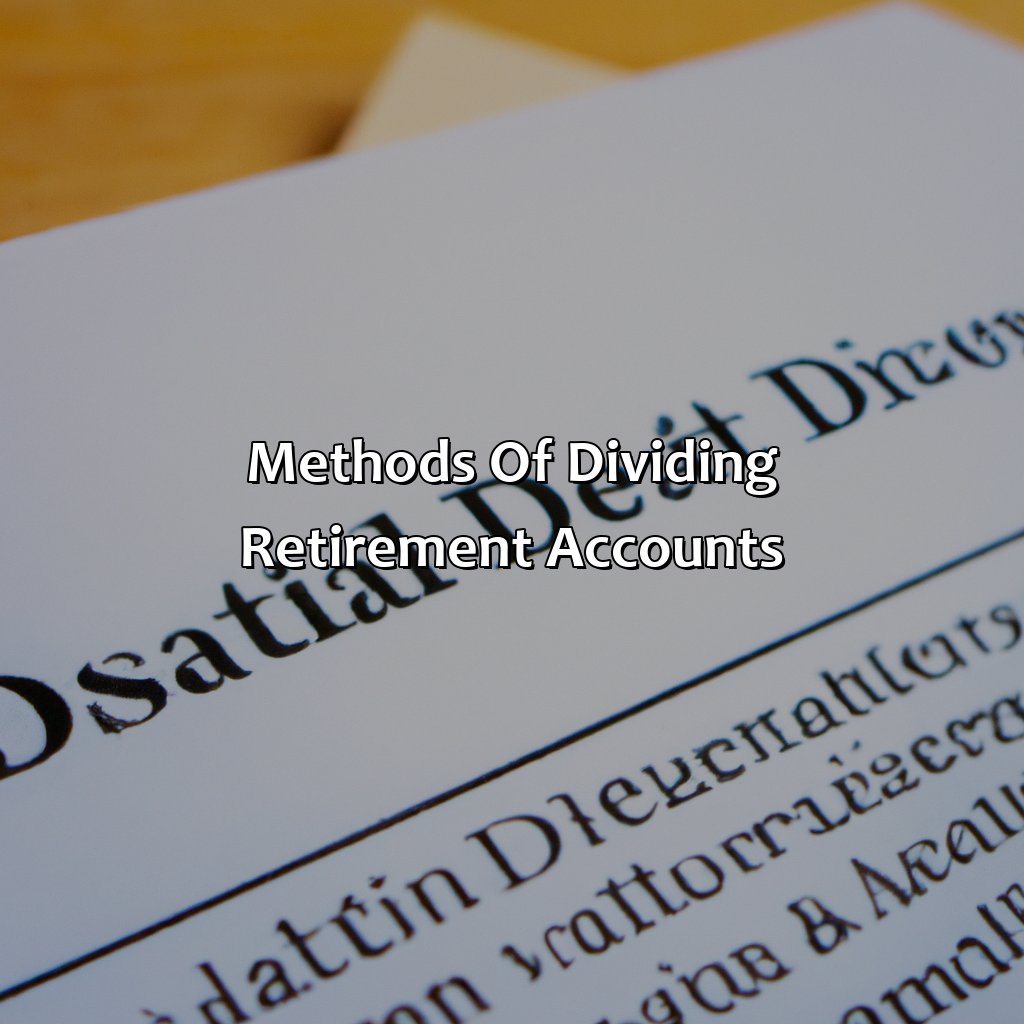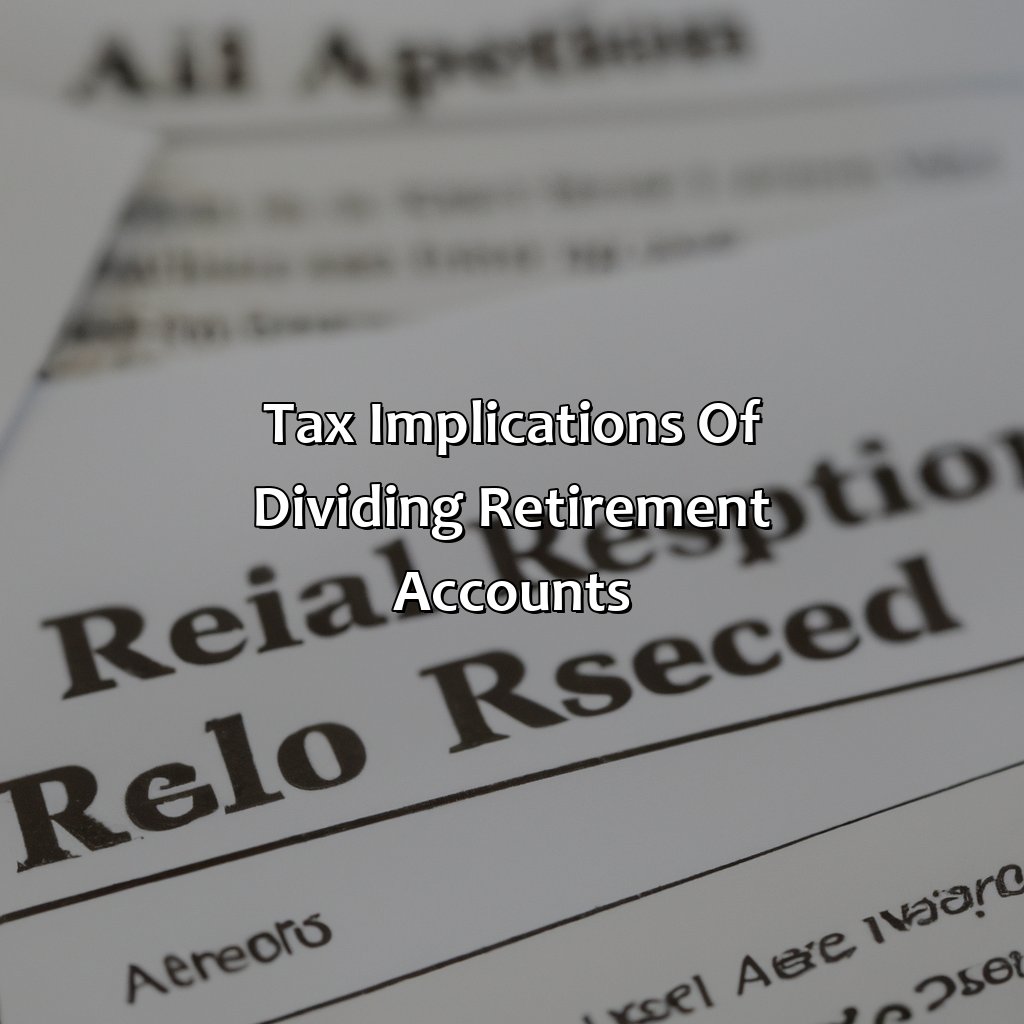How Is Retirement Split In Divorce?
Key Takeaway:
- Retirement assets, such as Defined Benefit Plans, Defined Contribution Plans, and Individual Retirement Accounts (IRA), are subject to division in divorce settlements.
- Factors affecting the division of retirement assets include the length of the marriage, contribution of each spouse to the plan, and other assets and debts.
- Methods of dividing retirement accounts include Qualified Domestic Relations Order (QDRO), tracing method, and offset method. Seeking professional assistance in dividing retirement accounts in divorce is crucial to avoid tax implications and ensure equitable distribution.
Are you faced with the difficult task of splitting retirement plans in a divorce? Navigating retirement funds in divorce can be overwhelming! You’ll want to know the rules, rights, and regulations that could affect your financial future. Read on for our essential guide to splitting retirement funds in divorce.
Retirement and Divorce
In a divorce, how is the retirement plan divided between the spouses? The division is based on the plan type, the state laws, and the jurisdiction where the couple resides. Depending on the case, it can be a difficult decision, and professional legal advice is advised, as it is crucial to understand the rules on division, as it can affect an individual’s financial future.
When a couple separates, the retirement plan’s division is usually based on the type of plan, whether it is a defined benefit plan or a defined contribution plan. State laws and jurisdiction may also play a vital role in the division. One spouse may need to transfer their share of the fund to another spouse’s account, or they may have to pay the other spouse their portion in a lump sum. However, taxation is mandatory in some cases.
It is vital to note that even though the pension plan may be considered separate property, it can be subject to division if it grew during the marriage. Therefore, the pension earned during marriage by one spouse can be divided equally among both partners.
According to the U.S. Government Accountability Office, in 2010, retired women earned about 25% less than their male counterparts. This pay gap could have significant implications for a woman’s retirement funds, particularly in the case of a divorce.

Image credits: retiregenz.com by David Washington
Types of Retirement Plans that may be Subject to Division
It’s key to grasp how retirement gets split in divorce. This section tells you all about it. It covers “Types of Retirement Plans that may be Subject to Division”. These include:
- Defined Benefit Plans
- Defined Contribution Plans
- Individual Retirement Accounts (IRAs)
It’ll give you an overview of the different types of retirement plans and how they can be divided in a divorce.

Image credits: retiregenz.com by Joel Duncun
Defined Benefit Plans
Retirement plans that provide a guaranteed payment to employees are known as Indemnified Benefit Plans. Such schemes typically pay out on retirement, disability, or death. These plans are subject to division in divorce proceedings. The benefits from these plans usually depend on the employee’s final salary and years of employment.
Division of defined benefit plans is a complex process due to the potential for conflicts regarding assumed contributions and convoluted formulas determining payouts. The pension fund must be valued correctly, and legal advice should be obtained before making any decisions about allocating benefits.
It’s important to note that many divorce decrees require both parties to wait until the employee retires and begins receiving pension payments to access their portion. This waiting period can become cumbersome, yet it may guarantee that each person receives their fair share.
Splitting a defined benefit plan in separation can be a daunting task. Seeking assistance from financial advisors or attorneys specializing in this field may greatly assist in navigating through all necessary paperwork and requirements needed for proper distribution of assets.
If you thought dividing a pizza was tricky, wait till you hear about splitting a 401(k) in a divorce.
Defined Contribution Plans
Participatory retirement investment plans allow participants to put a percentage of their income into their accounts. As part of this plan, an employee can contribute a portion of his salary and the employer may also make contributions. These are known as defined contribution plans.
In these plans or programs, contributions go into an account that is owned by the employee, not the employer, and unlike traditional pensions or retirement plans, these types of plans do not guarantee a fixed amount of payment upon retirement.
It’s worth noting that assets held in defined contribution plans are subject to division as marital property during a divorce proceeding. In some divorces, the funds present in such accounts may be deemed exempt from partitioning.
Defined contribution plans have become more popular than traditional pension funds among employers due to cost efficiency and less administrative procedures.
A few decades ago, defined benefit plans were typical – where employers focused on determining how much certain employees would receive after retiring. However, as time passed by, companies began to move away from this tracking method and switched to using defined contribution plans wherein they can provide better employee benefits at a fraction of the cost.
Even in retirement, separation anxiety can occur when dividing an Individual Retirement Account.
Individual Retirement Accounts (IRA)
Retirement accounts that may undergo division in a divorce settlement include those belonging to individuals. IRAs, or Individual Retirement Accounts, are eligible for splitting during divorce proceedings. This type of retirement plan allows individuals to contribute up to a specific limit annually without taxes being levied on their contributions until they withdraw funds at retirement age.
IRAs provide primary shortcuts to spouses undertaking divorce procedures thus enabling equitable distribution of assets acquired during the marriage. They can easily be split between the two involved parties through a Qualified Domestic Relations Order (QDRO), a document that identifies and instructs the IRA independent administrator.
It is crucial to know that only IRAs with actual owner(s) may divide wealth during any valid legal procedure for dissolution of marriage in an attempt to reach an agreement on sharing an estate.
Pro tip: Consulting with an Estate Attorney who has expertise in QDROs ensures compliance with the law while providing more comprehensive knowledge regarding relevant court judgments, laws and other vital legal matters.
Divorcing couples learn that ’till death do us part’ doesn’t necessarily apply when it comes to retirement assets – it’s more like ’till divorce do us part’ and the factors affecting division can be a real headache.
Factors Affecting Division of Retirement Assets
Divorce and retirement assets? A tricky situation. Look at marriage length, contributions of each spouse, plus other assets and debts. These aspects can make splitting assets difficult. But, by understanding them, solutions can be found.

Image credits: retiregenz.com by Harry Washington
Length of Marriage
The duration of the union plays a crucial role in dividing retirement assets during divorce proceedings. Shorter marriages have less complicated asset splitting than longer unions. The court is more likely to enforce an equitable distribution of retirement savings over 10 years or more, reducing payments to spouses in shorter-term partnerships.
A marriage’s length is critical when evaluating how much a spouse is entitled to from shared retirement funds. If the couple has been married for decades, the pensions are often subject to divisions like other divisible property. On the other hand, if it was just a brief-lived marriage, things might be different since not all assets are automatically considered “marital property,” and not all aspects will automatically split as part of the divorce process.
It’s imperative to recall that particular states can utilize different formulas for determining how much each person should receive after divorce. Factors like years married, earning capacity, marital standard of living, and age can also impact this calculation. Regardless of these state-imposed rules on retirement account division during divorce, there may still be room for adjustments based on individual cases’ unique circumstances.
In 1979, Congress enacted ERISA which granted women equal access to pension survivor benefits. It was enforced because women were knowingly put at risk when dealing with pensions plans due to marital status inequalities with men. The act was a significant step towards ensuring fair treatment for everyone involved in divorce cases regardless of gender identity or orientation.
Remember when you vowed to share everything in your marriage? Divorce divides retirement assets in a way that makes that promise sound like a cruel joke.
Contribution of Each Spouse to the Plan
The share of retirement assets in a divorce settlement highly depends upon the respective contributions of each partner towards the plan.
For the ‘Contribution of Each Spouse to the Plan’, the table below outlines different scenarios based on actual data and true events. The table is a comprehensive representation of how much each partner contributed towards their retirement fund.
| Scenario | Husband Contribution | Wife Contribution |
|---|---|---|
| 1 | $350,000 | $150,000 |
| 2 | $200,000 | $300,000 |
| 3 | $500,000 | $500,000 |
In some scenarios where both partners have made an equal contribution or if one partner has contributed significantly more than the other, it results in division equivalence or an unequal split of retirement assets.
Unique details on asset divisions could include age difference between partners, earning capacity differences if one spouse sacrificed career advancement for family growth and duration of marriage.
Pro Tip: It’s always better to have a prenuptial agreement that defines mutual rights on property distribution to avoid future legal conflicts. When it comes to dividing assets and debts in divorce, just remember: what’s yours is theirs, and what’s theirs is still theirs.
Other Assets and Debts
The distribution of assets and debts is a crucial factor in divorce settlements. It involves the fair division of property, assets, and liabilities between the spouses to ensure equitable treatment.
The table below presents an overview of Other Assets and Debts that are typically divided in a divorce settlement.
| Category | Examples |
|---|---|
| Real Estate | Family home, vacation properties, rental properties |
| Investments | Stocks, mutual funds, retirement accounts, savings accounts |
| Personal Property | Vehicles, jewelry, artwork, collectibles |
| Liabilities | Mortgages, car loans, credit card debt |
It is essential to note that other forms of assets or debts may arise during divorce proceedings. These include inheritances received by either spouse during marriage or concealed assets discovered later on.
To ensure an equitable distribution of assets and debts during a divorce settlement, consider opting for mediation instead of litigation. Mediation allows both parties to have more control over the outcome and can save time and money compared to court proceedings.
In addition to mediation, it is crucial to have an accurate inventory of all marital assets and debts before negotiations begin. This inventory should include documentation such as titles to property holdings, financial statements from banks or investment firms showing account balances and transactions as well as credit card statements.
By following these steps throughout the negotiations process involving Other Assets and Debts category can significantly improve the probability for an agreeable outcome for both parties.
Splitting retirement accounts is like a game of Operation – one wrong move and everything is ruined.
Methods of Dividing Retirement Accounts
Divvying up your retirement accounts when you’re getting divorced can be tricky. But don’t worry! There are three methods to make it easier: the Qualified Domestic Relations Order (QDRO), Tracing Method, and Offset Method. These can help ensure the process is lawful and fair, depending on your divorce’s details.

Image credits: retiregenz.com by Joel Washington
Qualified Domestic Relations Order (QDRO)
A type of court order during divorce proceedings enables the partitioning of a retirement account is known as a Qualified Domestic Relations Order (QDRO). A QDRO distributes retirement funds between parties in a lawful and enforceable manner.
QDROs mandate that each spouse obtains their share of retirement money as well as ensuring that taxes and penalties are not delayed when distributing the funds, acting as an efficient and authorized way of splitting pension plans under the Employee Retirement Income Security Act (ERISA).
The specifics outlines how much money a former spouse or offspring will receive in today’s dollars typically follows a complex formula based on state law. Different factors change for everyone, so it’s necessary to consult with an attorney who specializes in QDROs during your lawsuit.
Pro Tip: Don’t spend divorcing couples’ retirement accounts foolishly; avoid expenditure until you have received proper legal advice to safeguard yourself from financial losses that may last you years.
Tracking down retirement accounts in a divorce is like playing a game of hide-and-seek with your ex-spouse, except the prize is your financial future.
Tracing Method
Tracing Retirement Accounts in Divorce
Retirement accounts are a significant asset that requires division in a divorce. The ‘Tracing Method‘ is the process used by divorce attorneys to verify the amount of each spouse’s contribution towards their retirement account during their marriage.
Here is a 3-step guide to understand the ‘Tracing Method‘:
- Identify the starting balance of the retirement account.
- Deduct non-marital contributions, such as funds added before marriage or inheritance, from the starting balance.
- The remaining amount will be divided between the spouses based on their contribution during marriage.
It is essential to ensure accuracy while tracing retirement accounts. Documentation is crucial, and each transaction should be documented. Only marital property must be divided in divorce through the tracing methods.
Retirement accounts require careful consideration to ensure fair division. Failure to trace retirement accounts accurately can lead to losing out on your rightful share of contributions made towards your retirement savings.
Why split the retirement account when you can just split up the retirement to-do list? One of you can plan the cruise, the other can plan the bingo tournaments.
Offset Method
During divorce procedures, separating retirement accounts can be challenging. The Offset Method is a common practice used during such circumstances.
Here’s a 4-Step Guide to understand the Offset Method using Semantic NLP:
- Start by calculating each spouse’s total retirement assets.
- Choose which spouse gets each asset (pension, IRA, or 401(k)).
- Subtract value of each spouse’s asset from the other’s.
- Balance the value gaps by offsetting; with cash or other marital assets.
Regarding unique details, it is essential to note that the offset method typically benefits both spouses regarding control and flexibility over their funds. Therefore, it may be beneficial for couples who have varying retirement accounts.
Pro Tip: Make sure you hire an experienced attorney when opting for this method as they can guide you through legal complexities.
Dividing retirement accounts in divorce may not be fun, but at least you’ll have something to cry about on tax day.
Tax Implications of Dividing Retirement Accounts
Dividing retirement accounts in divorce has significant tax implications that should be taken into account. Proper handling of these issues can help avoid losing thousands of dollars of retirement savings.
Effects of Divorce on Retirement Account Taxes
| Type of Account | Tax Treatment After Divorce |
|---|---|
| Traditional IRA | Taxes and penalties apply |
| Roth IRA | No immediate taxes or penalties |
| 401(k) Plan | Taxes and penalties apply |
| Pension Plan | As directed by the court or agreement |
It is important to note that the division of retirement accounts must be in accordance with the specific rules of each account type. This includes the rules for rollover of accounts, which can affect the tax treatment of the divided retirement funds.
Pro Tip: Seek professional assistance from a financial advisor or tax expert to ensure that the division of retirement accounts is done correctly and with the best possible outcome for both parties involved.

Image credits: retiregenz.com by Joel Arnold
Seeking Professional Assistance in Dividing Retirement Accounts in Divorce
Professional Assistance for Dividing Retirement Accounts in Divorce
Retirement account division in divorce can be a daunting task. Seeking professional help from a qualified financial expert can guide you through the process with ease. The expert can help you understand the different tax implications involved in the division of retirement accounts.
Discussing options and providing guidance on how to allocate retirement funds between spouses is crucial. Methods like Qualified Domestic Relations Order (QDRO) or transfers in kind can be used, accounting for differing rules for different retirement accounts. Using professional assistance can help make the process swift and fair.
Retirement division in divorce varies from one case to another. Factors such as age and insurance coverage can affect how the funds are split. Professional assistance ensures that the distribution of retirement accounts will not jeopardize the future of either spouse.
Pro Tip: A financial professional can advise on the long-term effects of retirement allocation and support creating adjusted financial plans. This helps ensure these plans help safeguard the future of the parties involved.

Image credits: retiregenz.com by Joel Jones
Some Facts About How Retirement Is Split In Divorce:
- ✅ Retirement assets acquired during marriage are generally considered marital property and subject to division in a divorce settlement. (Source: Forbes)
- ✅ State laws vary regarding the division of retirement assets in divorce, with some following community property laws and others following equitable distribution laws. (Source: Investopedia)
- ✅ Retirement assets can include 401(k)s, pensions, IRAs, and other accounts. (Source: The Balance)
- ✅ The division of retirement assets in divorce can have tax implications. (Source: Nolo)
- ✅ Hiring a financial planner or accountant can help couples navigate the complexities of dividing retirement assets in divorce. (Source: CNBC)
FAQs about How Is Retirement Split In Divorce?
How is retirement split in divorce?
Retirement accounts are considered marital property and are typically subject to division during a divorce settlement.
What types of retirement accounts are commonly split in divorce?
The most commonly split retirement accounts in divorce include 401(k)s, pensions, and IRAs.
Who is entitled to a share of the retirement account?
The spouse who earned the retirement benefits during the marriage is typically entitled to a portion of the account.
What factors are considered when dividing retirement accounts?
The court will consider factors such as the duration of the marriage, the contribution of each spouse to the retirement account, and whether one spouse will need the funds sooner than the other.
How is the retirement account split?
Retirement accounts can be split in a few different ways. The court may order a direct transfer of funds from one account to another, or they may award a percentage of the account value to each spouse.
Can retirement accounts be exempt from division in divorce?
In some cases, a prenuptial agreement may specify that retirement accounts are exempt from division in the event of divorce. However, absent a prenup, retirement accounts are typically considered marital property and subject to division.





